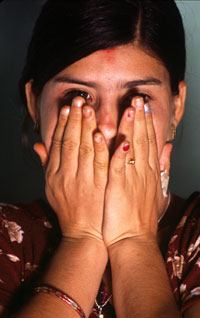 Lust for money is the root cause for Nepali girls being forced to become sex slaves in brothels in Mumbai and Kolkata, according to a report just released by INGO Terre des homes.
Lust for money is the root cause for Nepali girls being forced to become sex slaves in brothels in Mumbai and Kolkata, according to a report just released by INGO Terre des homes. Brothel owners, managers and traffickers are mostly Nepali and can recoup the 'purchase price' of new arrivals in up to seven months: meaning the money the girls earn by turning 10-12 tricks a day in their years of bondage that follow is pure profit. "To me the most significant thing we found is that the trafficker is a small
player. There is a very lucrative system down there in Bombay and Kolkata for the brothel owners," said John Frederick, research director of the study, at its release in Kathmandu on Tuesday.
"Client demand could be filled by girls 18 or older but the brothel owners' demand (for younger girls) is immense, it is a demand for free labour," he added.
The report, A Study of Trafficked Nepalese Girls and Women in Mumbai and Kolkata, is based on interviews in 2004 and 2005 with dozens of female sex workers, their clients, brothel owners, managers and locals living in red light areas in the two cities.
It details the various types of brothel set-ups, clients' feelings about the Nepali girls and women they go to for sex. There are also stories of their troubled lives from the shocked moment when they realise where they have been taken, right to the end of their 'term' years when they must choose the next step in their lives.
"I was very hesitant about using the word 'slavery' because it's a loaded word," said Frederick, "I had always thought that many girls entered into prostitution willingly (after) they had been thrown out of their houses or something similar but the only incidents we found were slavery, with a capital S."
The girls are between 14-16 when trafficked and on average spend three to five years in bondage but that can last as long as 10 years and ends at the whim of the brothel owner. This is the most perilous time for sex workers because they have no control over their lives or bodies. For instance, they are often forced to have sex without condoms and if they test positive for HIV are immediately thrown out of the brothel.
Once their enslavement ends (for most women between the ages of 18 and 22) the majority of sex workers exercise their freedom by entering into a new arrangement with the brothel owner, either renting a room where they live and work or paying to use a room to continue being sex workers or living elsewhere.
By then many have developed a 'mother-daughter' relationship with the Nepali owner or manager, someone with whom they share a language and culture amidst foreign people.
The UN's International Labour Organisation estimates that 30,000 Nepalis work in India's brothels. Most of those studied in the two Indian cities have passed through slavery to become 'free agents', according to Frederick. Many of them told researchers they would like to return to Nepal but knew they would be shunned by their families and communities. Surprisingly, they also feared being rescued by Nepali NGOs and put into what they consider institutional 'hell holes'.
Frederick cautioned that a heavy-handed approach, such as the one taken by Mumbai police, is not the answer. "People are terrified, 15 years of HIV/AIDS prevention work has been destroyed. If we bulldoze these brothels we're going to damage these women and damage their kids."
Instead, the solution starts with encouraging self-regulation in the brothels. In Kolkata, the Durbar Mahila Samanwaya Committee (DMSC) started in the 1990s with an HIV prevention program and now includes savings and credit projects, childcare, healthcare and self-regulation committees that screen each new sex worker to ensure she is not under 15 or a trafficking victim.
That work has reduced the number of sex slaves in Kolkata's brothels-but "there is no evidence that trafficking of Nepalese has diminished in India as a whole" concludes the report. That will require further work in other cities.


